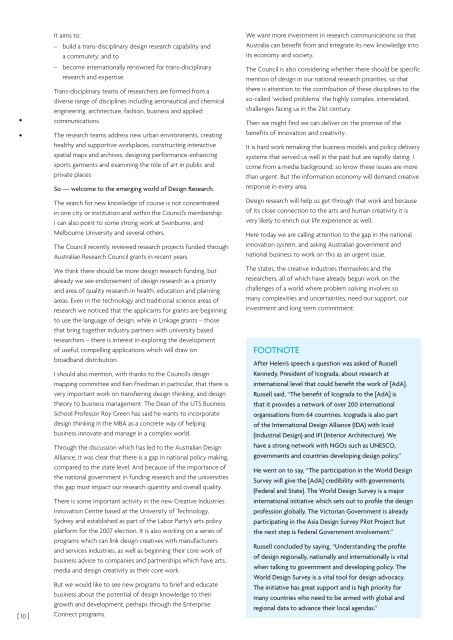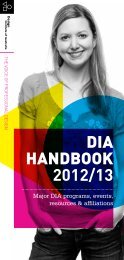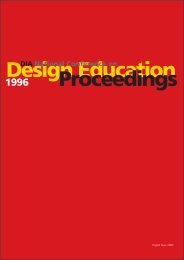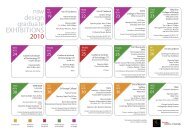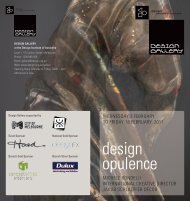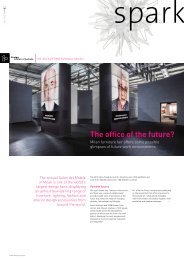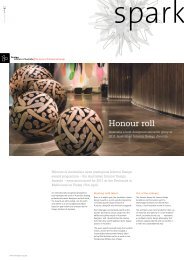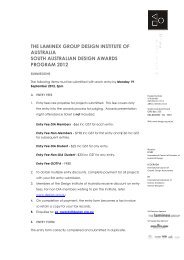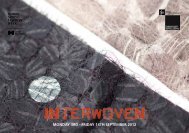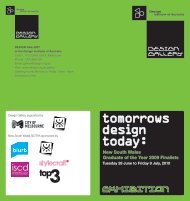Launch Report - Design Institute of Australia
Launch Report - Design Institute of Australia
Launch Report - Design Institute of Australia
You also want an ePaper? Increase the reach of your titles
YUMPU automatically turns print PDFs into web optimized ePapers that Google loves.
:<br />
[ 10 ]<br />
It aims to:<br />
– build a trans-disciplinary design research capability and<br />
a community; and to<br />
– become internationally renowned for trans-disciplinary<br />
research and expertise.<br />
Trans-disciplinary teams <strong>of</strong> researchers are formed from a<br />
diverse range <strong>of</strong> disciplines including aeronautical and chemical<br />
engineering, architecture, fashion, business and applied<br />
communications.<br />
The research teams address new urban environments, creating<br />
healthy and supportive workplaces, constructing interactive<br />
spatial maps and archives, designing performance-enhancing<br />
sports garments and examining the role <strong>of</strong> art in public and<br />
private places<br />
So — welcome to the emerging world <strong>of</strong> <strong>Design</strong> Research.<br />
The search for new knowledge <strong>of</strong> course is not concentrated<br />
in one city or institution and within the Council’s membership<br />
I can also point to some strong work at Swinburne, and<br />
Melbourne University and several others.<br />
The Council recently reviewed research projects funded through<br />
<strong>Australia</strong>n Research Council grants in recent years.<br />
We think there should be more design research funding, but<br />
already we see endorsement <strong>of</strong> design research as a priority<br />
and area <strong>of</strong> quality research in health, education and planning<br />
areas. Even in the technology and traditional science areas <strong>of</strong><br />
research we noticed that the applicants for grants are beginning<br />
to use the language <strong>of</strong> design, while in Linkage grants – those<br />
that bring together industry partners with university based<br />
researchers – there is interest in exploring the development<br />
<strong>of</strong> useful, compelling applications which will draw on<br />
broadband distribution.<br />
I should also mention, with thanks to the Council’s design<br />
mapping committee and Ken Friedman in particular, that there is<br />
very important work on transferring design thinking, and design<br />
theory to business management. The Dean <strong>of</strong> the UTS Business<br />
School Pr<strong>of</strong>essor Roy Green has said he wants to incorporate<br />
design thinking in the MBA as a concrete way <strong>of</strong> helping<br />
business innovate and manage in a complex world.<br />
Through the discussion which has led to the <strong>Australia</strong>n <strong>Design</strong><br />
Alliance, it was clear that there is a gap in national policy making,<br />
compared to the state level. And because <strong>of</strong> the importance <strong>of</strong><br />
the national government in funding research and the universities<br />
this gap must impact our research quantity and overall quality.<br />
There is some important activity in the new Creative Industries<br />
Innovation Centre based at the University <strong>of</strong> Technology,<br />
Sydney and established as part <strong>of</strong> the Labor Party’s arts policy<br />
platform for the 2007 election. It is also working on a series <strong>of</strong><br />
programs which can link design creatives with manufacturers<br />
and services industries, as well as beginning their core work <strong>of</strong><br />
business advice to companies and partnerships which have arts,<br />
media and design creativity as their core work.<br />
But we would like to see new programs to brief and educate<br />
business about the potential <strong>of</strong> design knowledge to their<br />
growth and development, perhaps through the Enterprise<br />
Connect programs.<br />
We want more investment in research communications so that<br />
<strong>Australia</strong> can benefit from and integrate its new knowledge into<br />
its economy and society.<br />
The Council is also considering whether there should be specific<br />
mention <strong>of</strong> design in our national research priorities, so that<br />
there is attention to the contribution <strong>of</strong> these disciplines to the<br />
so-called ‘wicked problems’ the highly complex, interrelated,<br />
challenges facing us in the 21st century.<br />
Then we might find we can deliver on the promise <strong>of</strong> the<br />
benefits <strong>of</strong> innovation and creativity.<br />
It is hard work remaking the business models and policy delivery<br />
systems that served us well in the past but are rapidly dating. I<br />
come from a media background, so know these issues are more<br />
than urgent. But the information economy will demand creative<br />
response in every area.<br />
<strong>Design</strong> research will help us get through that work and because<br />
<strong>of</strong> its close connection to the arts and human creativity it is<br />
very likely to enrich our life experience as well.<br />
Here today we are calling attention to the gap in the national<br />
innovation system, and asking <strong>Australia</strong>n government and<br />
national business to work on this as an urgent issue.<br />
The states, the creative industries themselves and the<br />
researchers, all <strong>of</strong> which have already begun work on the<br />
challenges <strong>of</strong> a world where problem solving involves so<br />
many complexities and uncertainties, need our support, our<br />
investment and long term commitment.<br />
Footnote<br />
After Helen’s speech a question was asked <strong>of</strong> Russell<br />
Kennedy, President <strong>of</strong> Icograda, about research at<br />
international level that could benefit the work <strong>of</strong> [AdA].<br />
Russell said, “The benefit <strong>of</strong> Icograda to the [AdA] is<br />
that it provides a network <strong>of</strong> over 200 international<br />
organisations from 64 countries. Icograda is also part<br />
<strong>of</strong> the International <strong>Design</strong> Alliance (IDA) with Icsid<br />
(Industrial <strong>Design</strong>) and IFI (Interior Architecture). We<br />
have a strong network with NGOs such as UNESCO,<br />
governments and countries developing design policy.”<br />
He went on to say, “The participation in the World <strong>Design</strong><br />
Survey will give the [AdA] credibility with governments<br />
(Federal and State). The World <strong>Design</strong> Survey is a major<br />
international initiative which sets out to pr<strong>of</strong>ile the design<br />
pr<strong>of</strong>ession globally. The Victorian Government is already<br />
participating in the Asia <strong>Design</strong> Survey Pilot Project but<br />
the next step is Federal Government involvement.”<br />
Russell concluded by saying, “Understanding the pr<strong>of</strong>ile<br />
<strong>of</strong> design regionally, nationally and internationally is vital<br />
when talking to government and developing policy. The<br />
World <strong>Design</strong> Survey is a vital tool for design advocacy.<br />
The initiative has great support and is high priority for<br />
many countries who need to be armed with global and<br />
regional data to advance their local agendas.”


